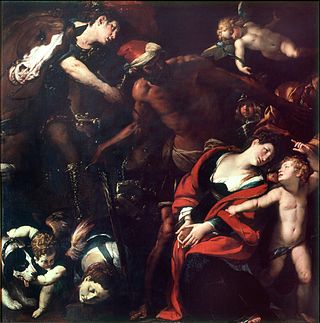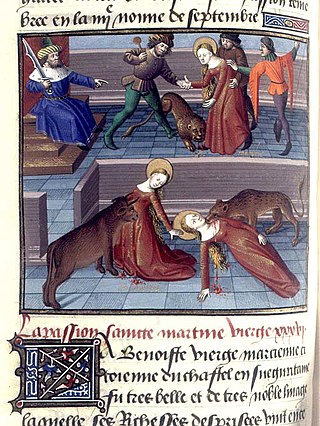
Pope Sixtus II, also written as Pope Xystus II, was bishop of Rome from 31 August 257 until his death on 6 August 258. He was killed along with seven deacons, including Lawrence of Rome, during the persecution of Christians by the Emperor Valerian.

Pope Stephen I was the Bishop of Rome from 12 May 254 to his death on 2 August 257. He was later canonized as a saint and some accounts say he was killed while celebrating Mass.
The 300s decade ran from January 1, 300, to December 31, 309.
The 250s was a decade that ran from January 1, 250, to December 31, 259.

Cyprian was a bishop of Carthage and an early Christian writer of Berber descent, many of whose Latin works are extant. He is recognized as a saint in the Western and Eastern churches.

July 29 - Eastern Orthodox Church calendar - July 31
In addition to Quadratus of Athens, there are several Christian saints with the name Quadratus :

Saints Protus and Hyacinth were Christian martyrs during the persecution of Emperor Valerian. Protus' name is sometimes spelled Protatius, Proteus, Prothus, Prote, and Proto. His name was corrupted in England as Saint Pratt. Hyacinth is sometimes called by his Latin name Hyacinthus. The day of their annual commemoration is mentioned in the "Depositio Martyrum" on September 11, in the Chronograph of 354.

Crispina was a virgin martyr of Africa who suffered during the Diocletian persecution. She was born at Thagora, a town in the Roman province of Numidia, located in Taoura, Algeria. in North Africa.) She died by beheading at Theveste, in Numidia.

Saints Cyprian and Justina are honored in the Catholic Church, Eastern Orthodox Church and Oriental Orthodoxy as Christians of Antioch, who in 304, during the Diocletianic Persecution, suffered martyrdom at Nicomedia on September 26. According to Roman Catholic sources, no Bishop of Antioch bore the name of Cyprian.

Julia of Corsica, also known as Julia of Carthage, and more rarely Julia of Nonza, was a virgin and martyr who is venerated as a saint. Her death occurred most probably in AD 439 or thereafter. She and Devota are the patron saints of Corsica in the Catholic Church. Julia was declared a patroness of Corsica by the church on 5 August 1809; Devota, on 14 March 1820. Both were martyred in pre-Christian Corsica under Roman rule. Julia's feast day is 22 May in the Western liturgical calendar and 16 July in the East.

Rufina and Secunda were Roman virgin-martyrs and Christian saints. Their feast day is celebrated on 10 July.

Christians were persecuted throughout the Roman Empire, beginning in the 1st century AD and ending in the 4th century. Originally a polytheistic empire in the traditions of Roman paganism and the Hellenistic religion, as Christianity spread through the empire, it came into ideological conflict with the imperial cult of ancient Rome. Pagan practices such as making sacrifices to the deified emperors or other gods were abhorrent to Christians as their beliefs prohibited idolatry. The state and other members of civic society punished Christians for treason, various rumored crimes, illegal assembly, and for introducing an alien cult that led to Roman apostasy. The first, localized Neronian persecution occurred under Emperor Nero in Rome. A number of mostly localized persecutions occurred during the reign of Marcus Aurelius. After a lull, persecution resumed under Emperors Decius and Trebonianus Gallus. The Decian persecution was particularly extensive. The persecution of Emperor Valerian ceased with his notable capture by the Sasanian Empire's Shapur I at the Battle of Edessa during the Roman–Persian Wars. His successor, Gallienus, halted the persecutions.

Marciana of Toledo, also known as Marciana of Mauretania and Marciana of Caesarea, is venerated as a martyr and saint.
The Martyrs of Abitinae were a group of 49 Christians found guilty, in 304, during the reign of the Emperor Diocletian, of having illegally celebrated Sunday worship at Abitinae, a town in the Roman province of Africa. The town is frequently referred to as Abitina, but the form indicated in the Annuario Pontificio is Abitinae. The plural form Abitinae is that which Saint Augustine of Hippo used when writing his De baptismo in 400 or 401.
Gaius Annius Anullinus was a Roman senator who was appointed consul in AD 295.

Justin the Confessor was a Christian martyr in the Roman Empire. He is honoured as a saint by the Roman Catholic Church and Eastern Orthodox Church.
The Martyrs of Sigum were a group of Nicomedians who were arrested and worked to death around 257 in the marble quarries of Sigum, Numidia, during the persecution of the Christians initiated by the Roman emperor Valerian. They were recognized as saints, with a feast day of 10 September.

The Martyrs of Carthage under Valerian were a group of Christians including Montanus, Lucius, Flavian, Julian, Victoricus, Primolus, Rhenus, and Donatian. All were executed during the persecutions of the Roman Emperor Valerian in 259 AD. Their feast day is 24 February.

Marculus of Thamugadi or simply Marculus was a prominent bishop and Christian martyr venerated by the 4th-century North African Donatist Church.















